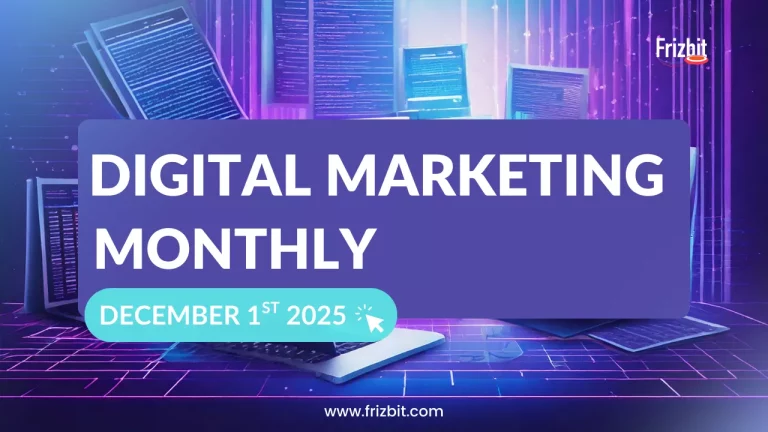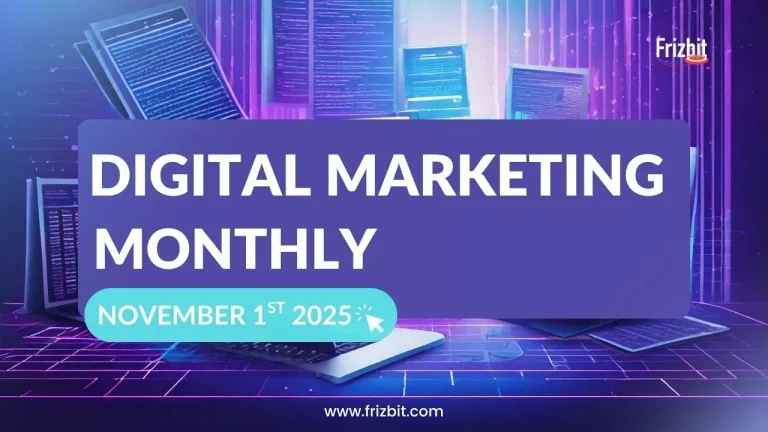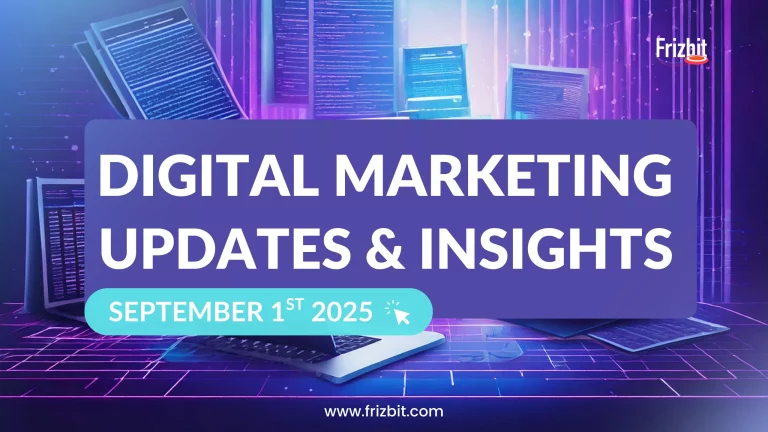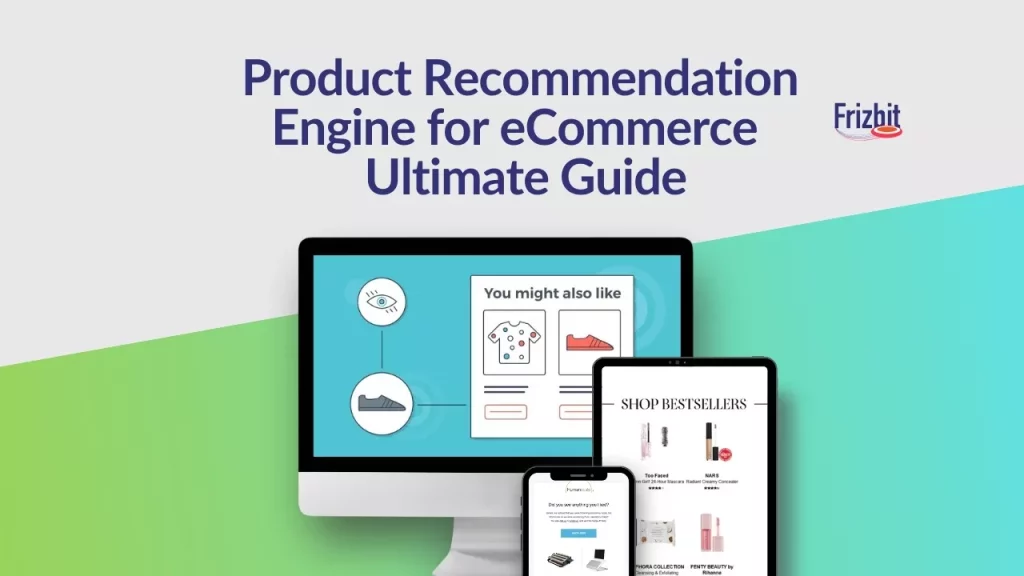
In the eCommerce industry, implementing a product recommendation engine is an essential tool to deliver personalised shopping experiences in your eCommerce. These recommendations not only enhance user engagement but also drive sales, foster customer loyalty, and increase revenue by 10%.
“People often don’t know what they want until you show it to them.”
Steve Jobs
Leveraging advanced algorithms and data analytics, businesses can offer tailored product suggestions that are so well cater to individual customer interests that turn into an impulsive purchase during their online shopping journey.
This guide delves into the various types of product recommendations, their benefits, best practices, important definitions, data collection methods, algorithms, and a checklist for selecting the right product recommendation engine.
Additionally, we present a research study on the UK market, offering valuable insights to help optimise your eCommerce platform.
1. What are Product Recommendations?
Definition
A Product recommendation engine enables you to provide suggestions to users based on various data points, such as their browsing history, purchase behaviour, and preferences. These recommendations are designed to enhance the shopping experience by helping users discover products they might be interested in.
They are shown in different formats including product carousels, pop-ups, and cross-sell bundles.
2. What are Product Recommendations Used For?
A Product recommendation engine is used to:
- Increase user engagement by showing relevant products.
- Boost conversion rates by suggesting items that customers are likely to purchase.
- Enhance customer satisfaction by providing a personalised shopping experience.
- Increase average order value (AOV) through cross-sell and upsell strategies.
3. Recommender Systems for Product Recommendations
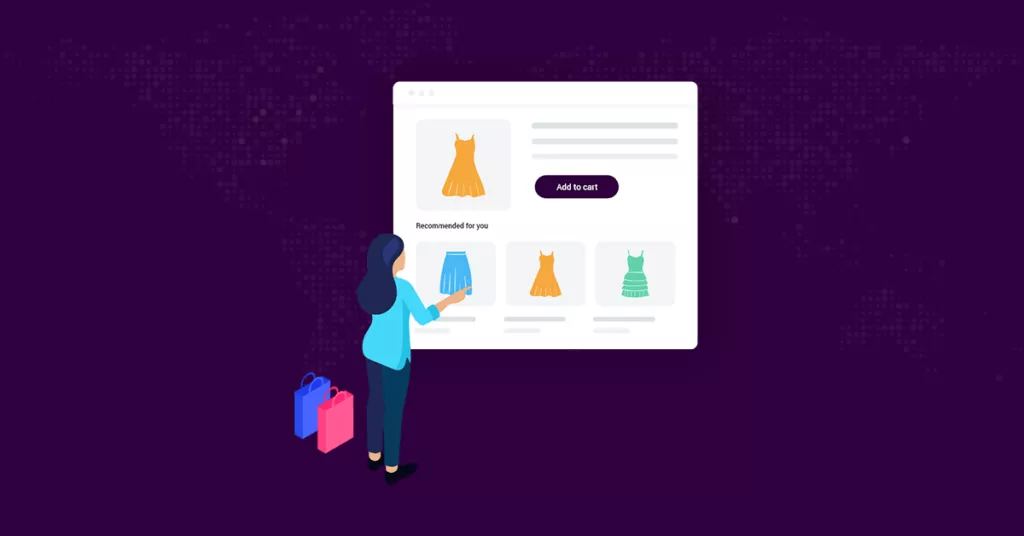
Here are some of the most frequent on-site recommendation systems:
- Frequently Bought Together: This type of product recommendation engine helps increase the average order value by encouraging customers to buy complementary products.
- Related Items:This helps users find alternatives or complementary products, enhancing their shopping experience.
- Newest Arrivals: This keeps customers informed about new offerings and can stimulate interest and sales.
- Trending Products: This leverages social proof to encourage customers to buy items that others are purchasing.
- Bestsellers: This type of product recommendation engine can increase conversions by showcasing items that have been validated by other customers.
- Most Viewed: This can indicate popular or highly interesting items.
- Recently Viewed: This helps in re-engaging customers and guiding them towards completing their purchase.
4. Product Recommendations during Customer Journey
Product recommendation engines can be strategically placed throughout the customer journey to enhance the shopping experience and drive sales.
Here’s a matrix showing which types of recommendations are suitable during different phases of the customer journey:
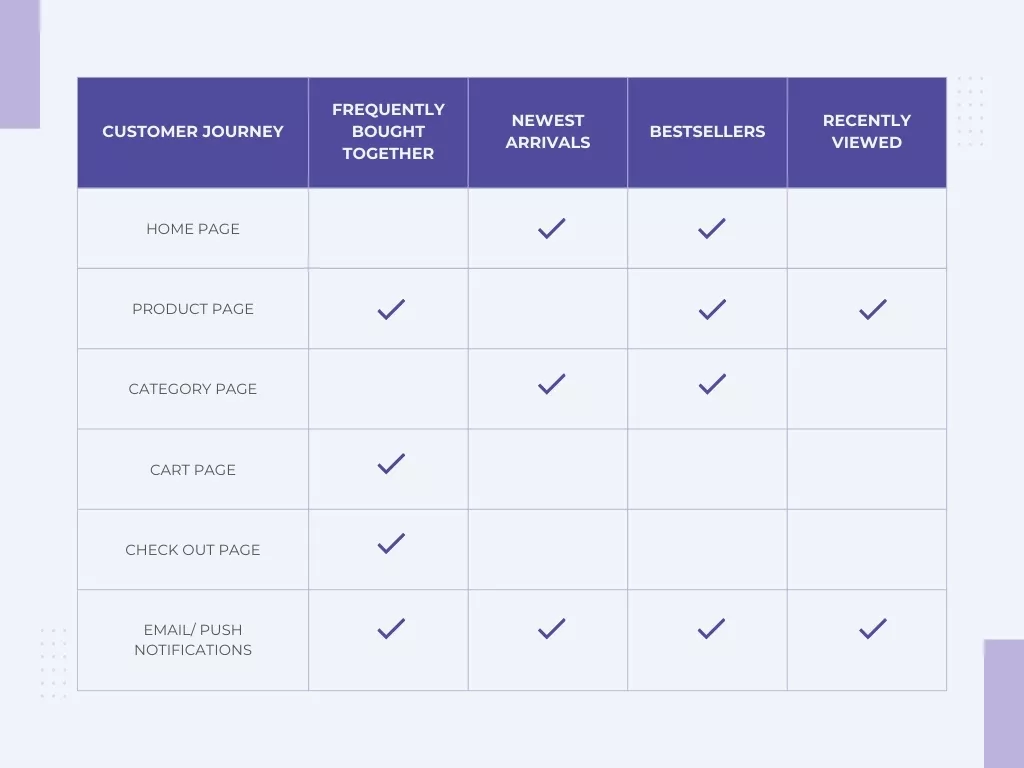
The matrix above shows the most effective recommendations at different stages.
On the Home Page, showcasing Newest Arrivals and Bestsellers captures initial interest. The Product Page benefits greatly from Frequently Bought Together suggestions, increasing order value by presenting complementary products.
The Cart Page is another critical stage for Frequently Bought Together recommendations, encouraging customers to add more to their cart. Email and Push Notifications are also effective, re-engaging customers by reminding them of Frequently Bought Together and Recently Viewed items.
Strategically placing these recommendations guides customers through their shopping journey, enhancing their experience and boosting sales.
6. Channels for Product Recommendations
Onsite and Offsite recommendation channels are essential for enhancing customer engagement and driving sales. Onsite recommendations offer real-time suggestions that guide purchasing decisions directly on your website or app. Meanwhile, Offsite recommendations through emails, push notifications, SMS, and WhatsApp re-engage customers even when they’re not actively browsing.
Onsite Recommendations
Pop-ups
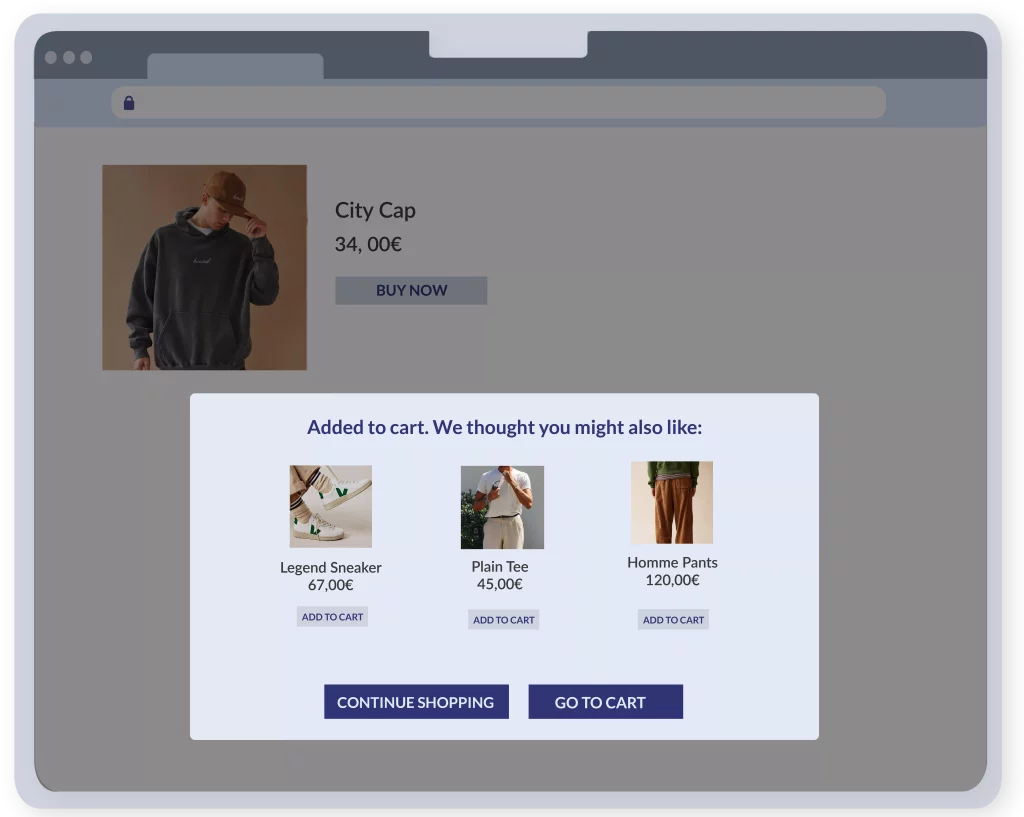
Pop-ups capture customer attention and drive additional sales by recommending complementary items.
For example, when a user adds a product to their cart, a pop-up can suggest related items to complete their purchase. This method reduces cart abandonment by up to 17% and increases average order values.
Sub-features:
- Product Recommendations Algorithms
- Pop-up Carousel
- Pop-up Bundles
Product Carousels
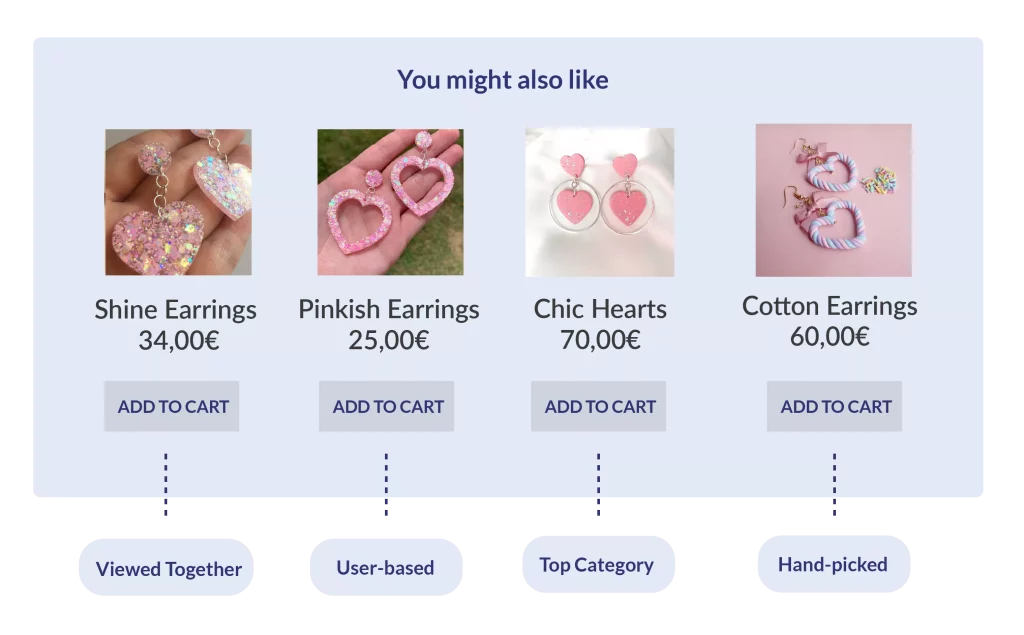
Product carousels dynamically showcase multiple products, enhancing product discovery and user engagement.
Carousels can be placed on product pages, home pages, category pages, and for cart recommendations, helping users find items of interest and increasing the likelihood of additional purchases.
Sub-features:
- Product Recommendations Algorithms
- Cart Carousel
Cross-sell Bundles
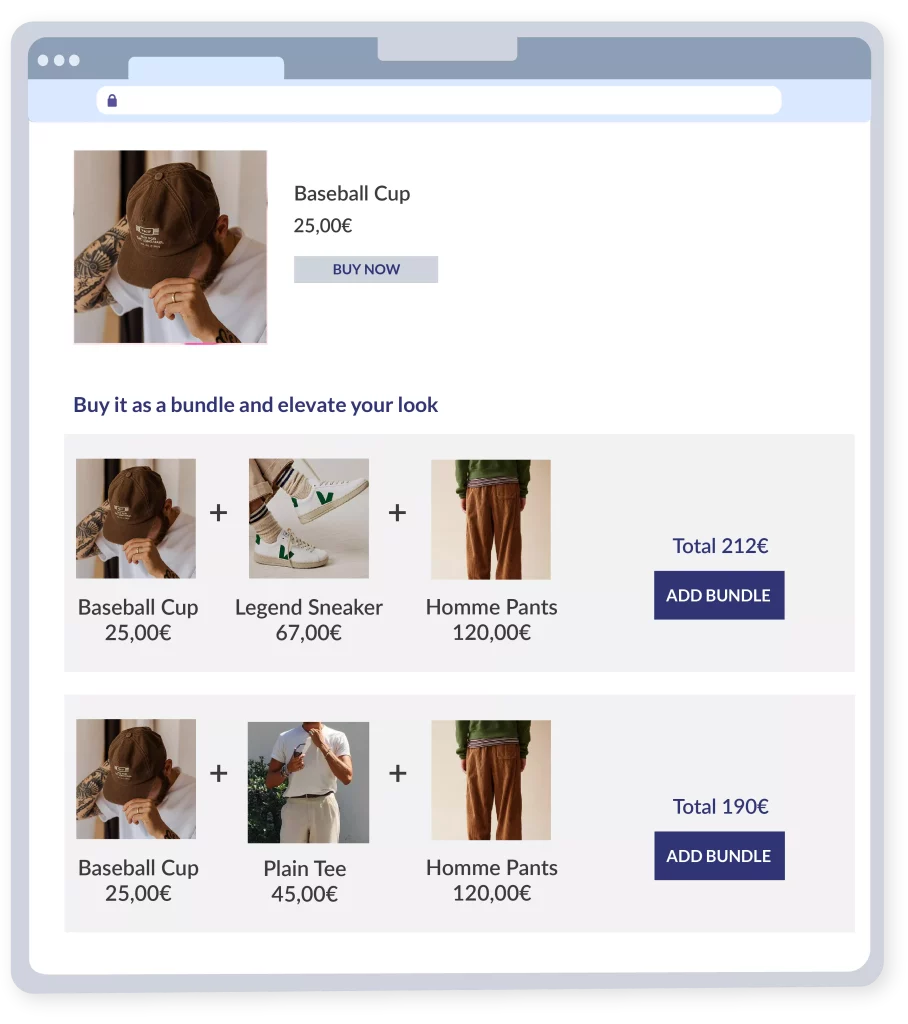
Cross-sell bundles suggest complementary products, increasing the average order value (AOV) and customer satisfaction. By leveraging existing purchase intent, cross-sell bundles ensure customers find everything they need in one place.
Sub-features:
- Product Recommendations Algorithms
- Cart Bundle
- Quick-add Bundle
In-app Recommendations
In-app recommendations provide personalised product suggestions directly within a mobile app, enhancing the user experience and encouraging additional purchases.
By analysing user behaviour within the app, such as browsing history and in-app actions, these recommendations help users discover relevant products seamlessly.
Sub-features:
- Real-time Recommendations
- Personalised Product Feeds
- Interactive In-app Banners
In-app recommendations can be strategically placed within various sections of the app, including the homepage, product pages, and during the checkout process.
Offsite Recommendations

Emails and Push Notifications
Emails and push notifications are powerful tools for retargeting customers with personalised product recommendations based on their previous interactions with the site.
- Emails: email campaigns include detailed product descriptions, prices, URLs, images, and hyper-personalised calls to action (CTAs).
- Web Push Notifications: web push notifications are sent without needing an app, work on both desktop and mobile devices, and can target anonymous users. They can be triggered by user behaviour such as cart abandonment, prompting users to return and complete their purchase.
SMS and WhatsApp Messages
Engaging customers on their preferred communication channels, such as SMS and WhatsApp, with personalised product recommendations can enhance the effectiveness of offsite marketing efforts.
- SMS Messages: SMS campaigns include the sender’s and recipient’s names, customised CTAs, and URLs. These messages are designed to reach users on both Android and iOS devices, ensuring broad coverage and high open rates.
- WhatsApp Messages: WhatsApp messages allow for personalised interaction with customers, including the use of personalised sender and receiver names, personalised CTAs, and URLs.
7. How do Product Recommendations Work?
A product recommendation engine works by leveraging algorithms and data collection to analyse user behaviour and preferences.
Data Collection
An effective product recommendation engine rely on several dimensions:
- User Interaction
Tracking purchase history, browsing history, search queries, add to wishlist and add-to-cart actions helps predict buying behaviour, reveal preferences, and suggest relevant products or accessories.
- User Profile
Demographics, preferences, personalised settings, and browsing behaviour are used to create personalised recommendations, tailoring suggestions to individual user profiles.
- Item Data
Product attributes, metadata, and inventory data ensure accurate matching of products with user preferences and availability, avoiding out-of-stock recommendations.
Product data feeds, includes basic details about available products on a site, such us: SKU, name, price, product URL, in-stock status, keywords, and images.
- Contextual Data
Time, location, seasonal trends, and device information influence shopping behaviour and recommendations, tailoring suggestions to the user’s context.
- External Data
Third-party data and market trends augment user profiles, ensuring recommendations are relevant and up-to-date.
Algorithms of Recommender Systems
Personalised recommendations have become a cornerstone of modern eCommerce, leveraging user data to create highly engaging shopping experiences.
Data from Frizbit illustrates that personalised recommendations can boost conversion rates by 20-30%, increase average order values by 20%, and elevate revenue by 7-15%.
To achieve such precise personalization, various algorithms are employed in recommender systems to process vast amounts of data to predict and suggest products that align with user preferences.
Below, we explore the primary types of recommender system algorithms, each contributing uniquely to the personalization process.
- Collaborative Filtering
Collaborative filtering predicts a user’s interests by collecting preferences from many users. This method can be:
- User-based: Recommends items that similar users have liked.
- Item-based: Suggests items that are similar to ones the user has liked in the past.
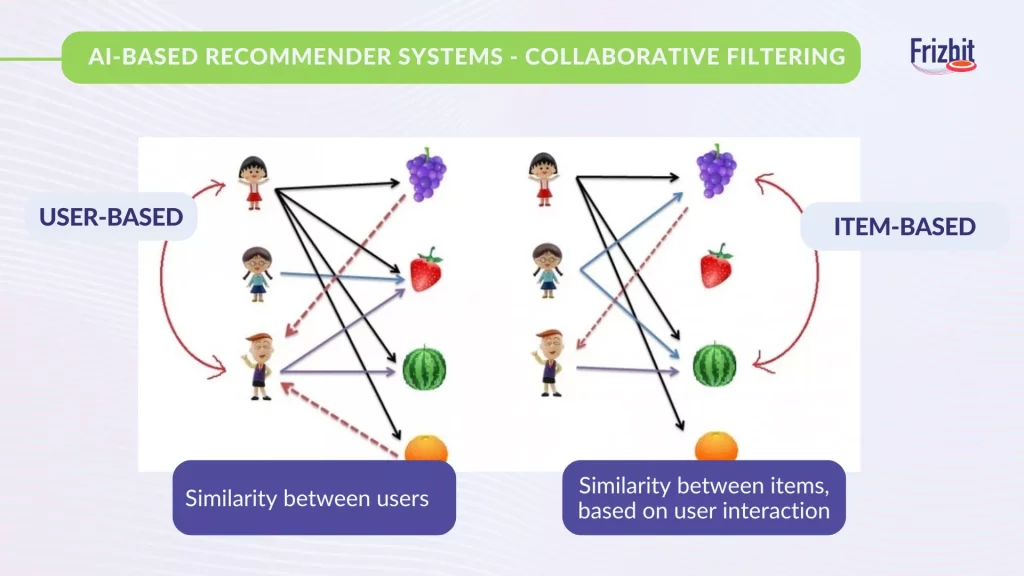
This approach has been successfully used by platforms like Amazon, which recommends products based on what similar customers have purchased, which draws approximately 35% of its revenue.
How does User-based differ from Item-based recommendations?
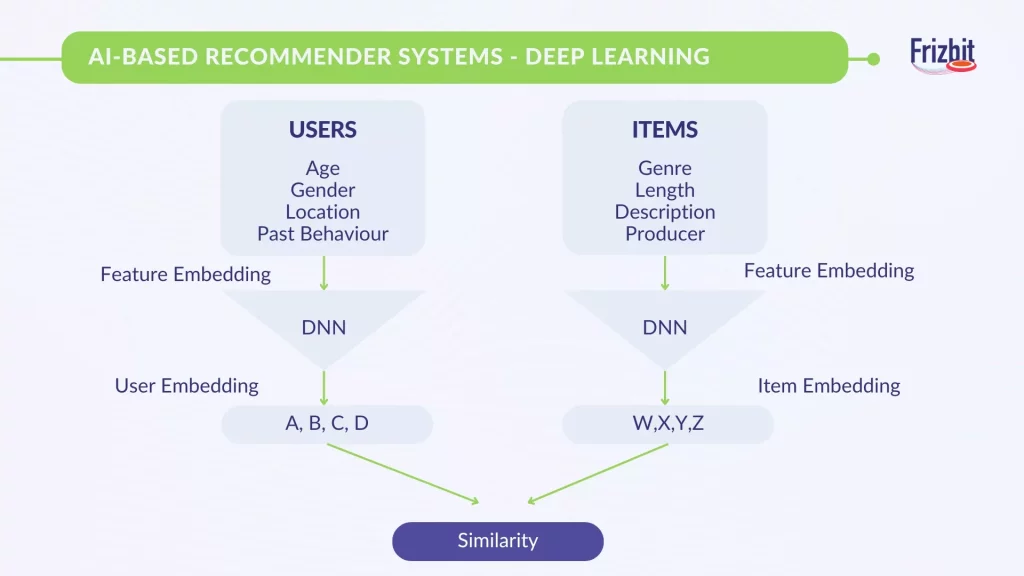
User-based recommendations focus on identifying similarities between users based on their attributes and behaviours, such as age, gender, location, and past behaviour, to suggest items liked by similar users.
In contrast, item-based recommendations identify similarities between items by analysing attributes like genre, length, description, and producer, recommending items that are similar to those a user has shown interest in.
- Content-Based Filtering
Content-based filtering recommends items based on product attributes and user profiles.
For example, if a user likes a particular book, the system might recommend other books by the same author or in the same genre. This method ensures that recommendations are directly related to the characteristics of the items the user has shown interest in.
Examples of Collaborative vs Content-Based Filtering

- Hybrid Systems
Hybrid systems combine collaborative filtering and content-based methods to improve recommendation accuracy. By leveraging the strengths of both approaches, hybrid systems can provide more precise and diverse suggestions.
For example, Netflix employs a hybrid recommendation system to suggest movies and TV shows, combining viewing history with user ratings.
- Deep Learning
Deep learning uses neural networks to analyse complex patterns in user behaviour and product attributes. This method can uncover deeper insights and provide highly accurate recommendations.
For example, Spotify uses deep learning to personalise music recommendations based on listening habits.
8. Visitor Type and Data Availability
Access to detailed data helps marketers understand buyer personas and purchase habits, informing segmentation and targeting strategies.
As users interact more with your site, the system gathers data to predict their preferences, enabling smarter segmentation and more relevant recommendations
Tailoring Product Recommendation engine Based on User Intent
The strategies and algorithms for recommendations should adapt to the user’s intent level, inferred from their behaviour and signals.
- Low Intent: Typically new visitors, unidentified users, those arriving via search or social media, or on mobile devices. These users often explore rather than commit to a purchase.
- Medium Intent: Returning visitors, identifiable users, those arriving directly or through email campaigns, often on desktop devices. These users show some interest and familiarity with the site.
- High Intent: Users who have made previous purchases, added items to their cart, or directly search for products on the site. These users are closer to making a purchase.
These classifications guide marketers in choosing appropriate strategies.
For low-intent users, a “Viewed Together” strategy can stimulate further exploration. For high-intent users, such as past purchasers, a “Purchased Together” strategy is more effective, enhancing cross-selling opportunities.
9. Checklist for Selecting a Product Recommendation Engine
Choosing the right recommendation engine is crucial for optimizing your eCommerce personalization strategy.
Here’s a checklist to guide you through the selection process:
- Multiple Data Sources: Incorporate various data types like purchase history, browsing history, search queries, demographics, preferences, product attributes, metadata, inventory levels, contextual data (time, location, device type), and third-party market trends.
- Quick ROI from Sales Data: Ensure the engine quickly generates logical recommendations without extensive data collection periods.
- GDPR Compliance: Implement robust data protection, manage user consent, and ensure transparency about data usage.
- AI and Human Balance: Use advanced algorithms and machine learning while allowing human experts to review and adjust recommendations.
- Strategy Support: Ensure easy integration with eCommerce platforms, scalability to handle data and traffic growth, robust technical support, and training materials.
By following this checklist, you can select a recommendation engine that enhances personalization, drives sales, and improves customer satisfaction and loyalty.
10. Benefits of using Product Recommendation Engine
Implementing a recommendation engine can significantly enhance your eCommerce platform by:
Increasing Average Order Value (AOV)
By suggesting complementary or premium products, recommendation engines encourage customers to add more items to their cart, boosting sales per transaction.
Reducing Bounce Rate
Personalised recommendations keep visitors engaged, reducing the likelihood of them leaving your site without making a purchase.
Enhancing Customer Loyalty
Offering tailored product suggestions creates a personalised shopping experience, fostering customer satisfaction and encouraging repeat visits.
Increased conversion rate
Recommendation engines improve conversion rates by presenting relevant products that align with user preferences and behaviour, making it more likely for users to make a purchase.
Boosting Revenue
The combined effect of higher AOV, lower bounce rates, and increased customer loyalty leads to substantial revenue growth.
Personalised recommendations drive higher engagement and conversion rates, maximizing profitability.
11. Choosing the right product recommendation engine strategy
Marketers should first consider the context of each user experience and the specific audience they are targeting.
When crafting recommendation plans, marketers can choose from three major types of strategies:
- Global Recommendation Strategies: Ideal for new users in their first session when there’s no user data profile available.
- Contextual Recommendation Strategies: Tailor recommendations based on product attributes (e.g., color, style), traffic source, device, operating system, local weather, time, and purchase frequency.
- Personalised Recommendation Strategies: The most sophisticated type, leveraging both product and user data to provide relevant recommendations for each individual user.
Examples of recommendation strategies
| Global Recommendation Strategies | Most Popular, Trending Now, New Products |
| Contextual Recommendation Strategies | Similar Products, Bought Together, Viewed Together |
| Personalised Recommendation Strategies | Collaborative Filtering, Affinity-Based Recommendations, Recently Viewed, Last/Recent Purchase, Bought with Last/Recent Purchase |
12. What Metrics Should Be Tracked to Optimise your Product Recommendation engine?
- Measures the percentage of users who click on a recommended product.
- Indicates the relevance and engagement level of recommendations.
Conversion Rate (CR):
- Tracks the percentage of users who make a purchase after clicking a recommendation.
- Assesses the effectiveness in driving sales.
Average Order Value (AOV):
- Calculates the average amount spent per transaction.
- Evaluates how well recommendations encourage additional purchases.
Engagement Rate:
- Measures user interactions with recommended products, such as views or cart additions.
- High rates suggest useful and relevant recommendations.
Bounce Rate:
- Tracks the percentage of users leaving after viewing only one page.
- Lower rates indicate effective retention through personalized recommendations.
Customer Lifetime Value (CLV):
- Estimates total revenue from a customer over their lifetime.
- Higher CLV reflects successful repeat purchases and loyalty fostered by recommendations.
- Assesses profitability by comparing revenue generated from recommendations to implementation costs.
- Higher ROI indicates a successful recommendation strategy.
12. Research Study | Market Insights: 300 UK eCommerce companies using product recommendation engine
To provide actionable insights and strategies for implementing AI-powered product recommendations, we’ve conducted a comprehensive research study on the UK eCommerce market.
Here’s a summary of the key findings from our study on the top 300 UK eCommerce companies with over 500k traffic per month:

The bar charts illustrate the usage and Quick Add inclusion percentages for different bundle types among companies.
- Cross-Sell bundles are the most widely used at 46%, with a high inclusion of Quick Add at 77%, indicating a strong emphasis on user convenience.
- Frequently bought Together bundles are used by 27% of companies, but only 36% include Quick Add, suggesting an opportunity for improvement.
- Cart Bundles, used by 21% of companies, have a high Quick Add inclusion at 76%, capturing last-minute purchase decisions effectively.
- Pop-up bundles are the least utilised at 14%, with 65% including Quick Add, targeting impulse buys.
Why is it Important to Have a Quick Add Option?
Including a Quick Add option in your product recommendation engine is crucial for improving the shopping experience and boosting sales.
According to a study by Baymard Institute, simplifying the process of adding items to the cart can significantly reduce cart abandonment rates, which currently average around 69.99% across eCommerce platforms.
This efficiency is further supported by insights from Shopify, indicating that streamlined checkout processes can increase conversion rates by up to 35%.
13. Conclusion
Implementing a product recommendation engine is crucial for enhancing personalised shopping experiences, boosting sales, and fostering customer loyalty. By leveraging advanced algorithms and data analytics, businesses can deliver tailored product suggestions based on individual customer behaviour and preferences.
Key benefits include increased user engagement, higher conversion rates, enhanced average order value, and improved customer satisfaction and retention.

